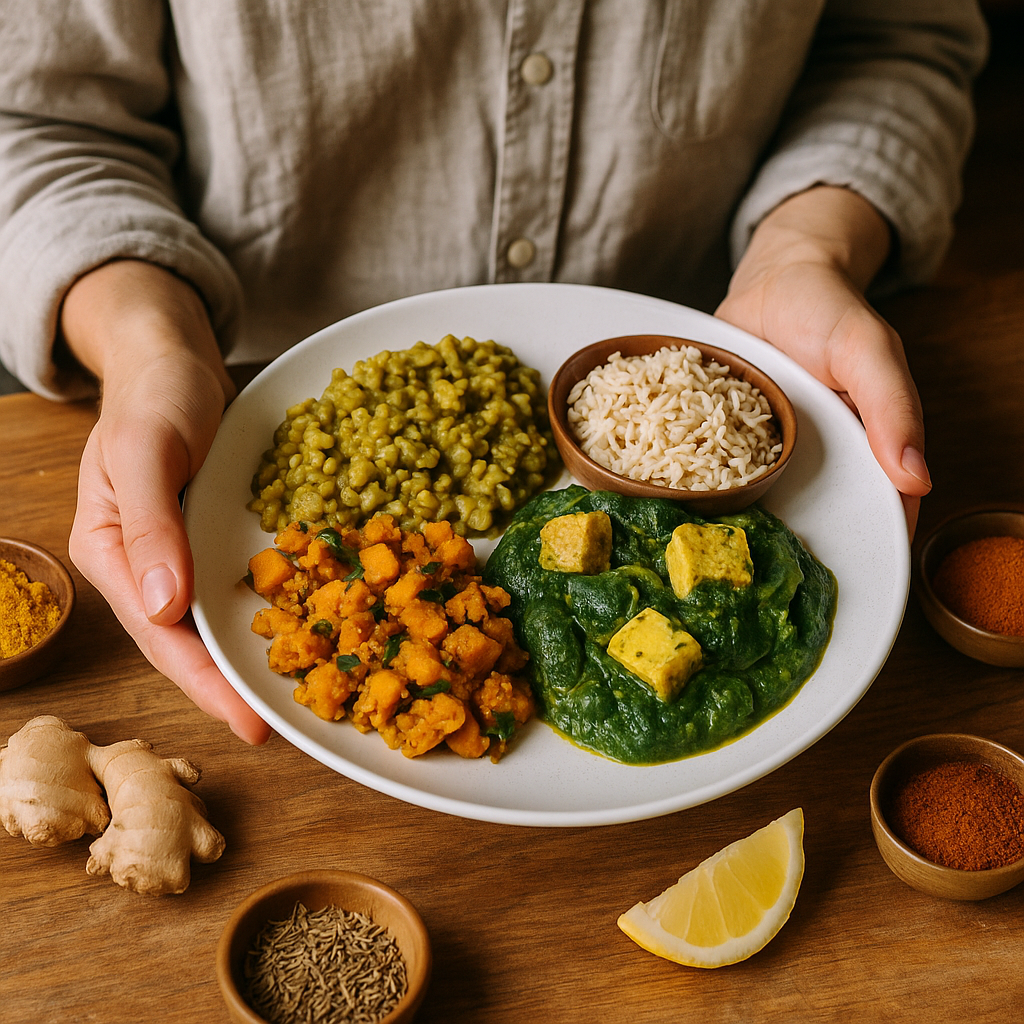Shop Now in Our Store
Body Types According to Ayurveda

So What’s Your Ayurvedic Body Type, Anyway? (And Why It Matters More Than You Think)
You’ve probably heard someone casually mention their “dosha” over turmeric tea, right? Maybe it sounded a little woo-woo, like zodiac signs for your digestion. But here’s the thing — Ayurvedic body types, or prakriti, aren’t just some mystical categorization. They’re the foundation of how this 5,000-year-old Indian healing system views your entire being — from what you eat to how you sleep to whether you thrive in cold weather or melt like ghee on a hot pan.
And here’s the kicker: understanding your Ayurvedic body type might just change the way you treat your health — forever.
Not in a "one size fits all" wellness way. No. Ayurveda is obsessed with personalization. It doesn’t just ask what’s healthy — it asks, “What’s healthy for YOU?”
So whether you’re Vata, Pitta, Kapha, or some glorious mix of all three (spoiler: most of us are), this isn’t just about classification. It’s about alignment. With your food. Your routine. Your mind. Even your morning coffee.
Let’s get into it.
So What Exactly Are These Ayurvedic Body Types?
Alright, some background. Ayurveda (Sanskrit for “the science of life”) breaks down every individual into three basic energy types or doshas: Vata, Pitta, and Kapha. These aren’t just metaphors. They reflect combinations of the five elements — space, air, fire, water, and earth — and they govern everything from your physical traits to your personality quirks.
Why This Stuff Actually Matters
Think of your dosha as your body’s operating system. It tells you why:
-
You bloat like a balloon after eating raw salads (hello, Vata).
-
You get hangry and flushed if lunch is five minutes late (classic Pitta).
-
You could nap through an earthquake and still feel groggy (oh hey, Kapha).
More importantly, it helps you balance these tendencies — using diet, lifestyle, herbs, yoga, breathing, and even sleep habits.
Ayurveda isn’t prescriptive — it’s responsive. It asks, What’s out of balance? And then it helps bring you back to center.
Why You Should Care About Lifestyle & Diet in This Context
Each dosha has:
-
Foods that fuel it.
-
Activities that ground or ignite it.
-
Sleep needs. Emotional triggers. Seasonal preferences.
-
Even a time of day it rules (yes, Ayurveda is that detailed).
And when your dosha is out of whack? You’ll feel it. Constipation, inflammation, weight gain, burnout — those are just surface-level signals. The deeper imbalance shows up in how your body feels, your moods, your immunity, and your connection to — well — yourself.
This article? It’s your roadmap. We’ll go dosha by dosha, and give you actual, doable Ayurvedic lifestyle and diet tools to support your prakriti. Not just theories. Practical stuff. The kind of advice you might scribble on a napkin over chai.

Understanding the Role of Ayurveda in Managing Body Types
Let’s go a little deeper.
What Ayurveda Says About Body Types
Ayurveda isn’t interested in cookie-cutter health. Instead, it wants to understand your original blueprint — the energetic ratio of Vata, Pitta, and Kapha you were born with. That combo forms your prakriti, or natural constitution. It rarely changes over your lifetime. What does change? Your vikriti — your current state of imbalance.
That’s where things get interesting.
Imagine someone born primarily Vata (light, airy, mobile) suddenly feels sluggish, gains weight, and becomes emotionally dull. That’s a Kapha imbalance in a Vata person. A “wrong direction” moment. Ayurveda notices that. It doesn’t just treat symptoms — it restores the doshic balance.
So in practical terms: your body type helps predict what’s likely to go off track — and how to realign.
How Ayurvedic Lifestyle & Diet Directly Impact Body Types
The reason Ayurveda emphasizes food and daily routine so much? Because those are the two things you can control daily. Every meal and habit either aggravates or pacifies a dosha.
-
Vata types need warm, grounding, oily foods — think soups, root veggies, ghee.
-
Pitta folks need cooling, hydrating, less spicy meals — cucumbers, mint, coconut.
-
Kapha people? They benefit from light, warming, astringent meals — ginger tea, legumes, greens.
But it’s not just about food. Ayurveda considers:
-
What time you eat.
-
Whether you eat distracted or mindfully.
-
Whether your sleep matches your constitution.
-
Even your emotional responses to stress.
Lifestyle isn’t some “extra.” It’s the medicine.
The Importance of Individualized Ayurvedic Approaches
Here’s where modern wellness often stumbles. It grabs one practice — intermittent fasting, say — and promotes it as a miracle for all. Ayurveda says: Hold up. Is that actually good for YOUR dosha?
For example:
-
Fasting might help a Kapha feel lighter — but make a Vata dizzy and depleted.
-
Cold smoothies in the morning might help cool a fiery Pitta — but send a Vata into digestive chaos.
This is why you need tailored recommendations, not trendy hacks.
No two bodies are identical. And no healing journey should be, either.
What to Eat (and Avoid) Based on Your Dosha: Ayurvedic Dietary Guidelines for Body Types
Food is medicine in Ayurveda — but it’s not one-size-fits-all. What grounds one person might totally throw another off balance. That’s why dosha-based eating is a thing. And once you dial it in, you start realizing... whoa, that bloated, foggy, or anxious feeling wasn’t random. It was food not vibing with your constitution.
Let’s unpack what Ayurveda says about what you should eat.
Foods Recommended by Ayurveda for Each Body Type
Vata (Air + Space)
Vata folks are cold, dry, light, and mobile. They need grounding, warming, moist foods to stay calm and nourished.
Best foods:
-
Stews, soups, root veggies
-
Ghee, avocado, soaked nuts
-
Warm milk with turmeric or nutmeg
-
Cooked grains like rice or oats
-
Spices like cumin, ginger, cinnamon
Pitta (Fire + Water)
Pittas are hot, sharp, and intense — so they need cooling, soothing, and hydrating foods.
Best foods:
-
Fresh fruits, cucumbers, melons
-
Leafy greens, asparagus, zucchini
-
Coconut water, dairy (if tolerated)
-
Basmati rice, barley
-
Spices like fennel, mint, coriander
Kapha (Earth + Water)
Kaphas are heavy, slow, and moist — so they benefit from light, dry, and warming foods.
Best foods:
-
Spices like black pepper, ginger, turmeric
-
Light grains (millet, quinoa)
-
Legumes, cruciferous veggies
-
Apples, berries, pears
-
Herbal teas with pungent herbs
Foods Ayurveda Suggests Avoiding for Each Body Type
It’s not about “never eat this again.” It’s about moderation and timing. But here’s the quick red-flag list:
-
Vata: Avoid raw salads, cold drinks, popcorn, beans (unless well-cooked), caffeine
-
Pitta: Avoid alcohol, spicy food, fried food, onions, fermented stuff (hello, kombucha overload)
-
Kapha: Avoid dairy, wheat, fried foods, sugar, heavy meats, bananas
Side note — it’s kind of freeing. Instead of chasing food trends, you just start listening to your body. And it gets easier with time.
Meal Planning and Timing Tips in Ayurveda for Body Types
This part feels a bit old-school, but it works.
-
Eat your biggest meal at lunch. That’s when digestive fire (agni) is strongest.
-
Stick to regular meal times. Especially if you’re Vata — irregular eating = chaos.
-
Don’t over-snack. Kapha types especially benefit from space between meals.
-
Warm food is better than cold, generally. It’s more digestible, grounding, and kind to your belly.
Hydration and Beverage Recommendations (If Applicable)
Water matters, but how and when you drink it matters more.
-
Vata: Sip warm herbal teas (chamomile, licorice) throughout the day
-
Pitta: Coconut water, mint tea, room-temp water with lime
-
Kapha: Ginger tea, cinnamon-clove decoctions, warm lemon water in the morning
Cold water straight from the fridge? Generally not Ayurvedic-friendly — it can kill your digestive fire. Room temp or warm is the way to go.

Living Like Your Dosha: Ayurvedic Lifestyle Practices for Body Types
Here’s where Ayurveda shines — the day-to-day stuff. Because it’s not just what you eat. It’s how you move, sleep, bathe, and even breathe.
Let’s talk daily rhythms — aka Dinacharya — that sync with your body type.
Daily Ayurvedic Routines (Dinacharya) to Manage Body Types
Start simple:
-
Wake up early (before sunrise if you can) — Kapha types especially benefit from an early start.
-
Scrape your tongue. Removes toxins, stimulates organs.
-
Abhyanga (self-massage with warm oil):
-
Vata: Sesame oil
-
Pitta: Coconut or sunflower oil
-
Kapha: Mustard or dry brushing if oil feels too heavy
-
-
Morning movement:
-
Vata = gentle yoga
-
Pitta = moderate walks
-
Kapha = energizing workouts or dancing in your kitchen (for real)
-
-
Evening wind-down: Herbal tea, foot massage, screens off, soft lights.
Sleep Patterns and Ayurvedic Guidelines for Body Types
-
Vata: Needs deep, regular sleep — aim for 8+ hours. Wind down early.
-
Pitta: Can be night owls — but should aim for 10–6. Avoid overstimulation before bed.
-
Kapha: Needs less sleep — but tends to oversleep. Get to bed by 10, wake by 6 max.
Try using natural cues: candlelight, moonlight, nature sounds — your nervous system loves that stuff.
Ayurvedic Personal Care Practices for Body Types
This might sound indulgent, but it’s about maintenance, not luxury.
-
Oil pulling (swishing sesame or coconut oil in the mouth): Detoxifying and strengthens gums.
-
Bathing rituals: Add herbs or essential oils based on your dosha.
-
Aromatherapy:
-
Vata = calming (lavender, vetiver)
-
Pitta = cooling (rose, sandalwood)
-
Kapha = stimulating (eucalyptus, rosemary)
-
Touch, scent, rhythm — they all impact how balanced (or not) your doshas are.
Move, Breathe, Repeat: Yoga & Breathing Techniques for Ayurvedic Body Types
Ayurveda and yoga are like best friends from birth. They grew up together. And their compatibility shows — each dosha benefits from specific postures and breathwork.
Let’s break it down.
Yoga Asanas Specifically Recommended for Each Body Type
Vata
Needs grounding, slow, steady movements.
Best poses:
-
Child’s pose, seated forward folds
-
Cat-cow, legs-up-the-wall
-
Mountain pose, tree pose
-
Longer holds, slow flows
Pitta
Needs cooling, relaxing, non-competitive practice.
Best poses:
-
Moon salutation
-
Spinal twists, pigeon pose
-
Bridge pose, seated meditation
-
Avoid hot yoga or too many inversions
Kapha
Needs stimulation, circulation, heat.
Best poses:
-
Sun salutations
-
Chair pose, warrior sequences
-
Boat pose, plank
-
Faster-paced vinyasa or dynamic movement
Pranayama (Breathing Exercises) That Improve Body Type Balance
Breath is subtle but potent. And tailored breathwork = instant balance.
-
Vata: Alternate nostril breathing (Nadi Shodhana), Ujjayi
-
Pitta: Sheetali or Sheetkari (cooling breath)
-
Kapha: Kapalabhati (skull-shining breath), Bhastrika (bellows breath)
Consistency matters more than intensity. Even 5 minutes daily works wonders.
How Often to Practice Yoga & Breathing Techniques for Body Types
-
Vata: Daily short sessions (20–30 mins) — consistency calms.
-
Pitta: 4–5x a week — focus on joy, not achievement.
-
Kapha: At least 5x a week — they need that fire to get moving.
Mix it up. Don’t force routines that bore you. Ayurveda encourages joyful effort, not rigid discipline.
Feeling Stressed? Ayurveda Has Thoughts on That: Stress & Emotional Health for Body Types
We can’t talk balance without addressing stress — the silent dosha-wrecker. Whether it shows up as anxiety (Vata), anger (Pitta), or inertia (Kapha), Ayurveda has tools to help.
Ayurvedic Techniques to Reduce Stress by Body Type
Vata
-
Routine. Soothing touch. Journaling. Warm baths.
-
Herbal support: Ashwagandha, Brahmi, nutmeg at night
Pitta
-
Time in nature. Water therapy. Cooling oils.
-
Herbal support: Shatavari, Gotu kola, rose
Kapha
-
Stimulation. Laughter. Social connection.
-
Herbal support: Tulsi, ginger, turmeric
Stress is sneaky — it builds quietly. Ayurvedic routines create a buffer against it.
Meditation and Mindfulness Practices Beneficial for Each Dosha
-
Vata: Body scan, guided visualizations, soft music
-
Pitta: Breath awareness, heart-centered meditations
-
Kapha: Walking meditation, chanting, energizing mantras
Don’t overthink it. Sit. Breathe. Notice. That’s it.
Emotional and Psychological Considerations in Ayurveda
-
Vata: Prone to fear, overthinking. Needs grounding, emotional safety.
-
Pitta: Prone to irritability, control issues. Needs compassion and forgiveness.
-
Kapha: Prone to attachment, stagnation. Needs stimulation, motivation.
Ayurveda sees emotional health as inseparable from physical health. You’re not just a body. You’re a whole, interconnected being. Wild, right?
Your Spice Rack is a Pharmacy: Practical Ayurvedic Home Remedies & Recipes for Body Types
Ayurveda doesn’t need you to order obscure herbs from distant online shops. Some of its most powerful remedies? Right there in your kitchen.
Let’s break this down by dosha — because one person’s miracle chai might be another’s digestive disaster.
Simple and Effective Home Remedies for Each Body Type
For Vata:
-
Warm sesame oil massage before bed = deeper sleep, calmer nerves
-
Ginger tea with honey (not in boiling water!) = digestion boost
-
Soaked dates and almonds = grounding morning snack
-
Golden milk with turmeric and nutmeg = great for immunity + sleep
For Pitta:
-
Coriander-fennel-cumin tea = cooling and reduces acidity
-
Aloe vera juice (unsweetened) = liver support + heat relief
-
Coconut oil scalp massage = cools fiery emotions (and prevents hair thinning)
-
Rosewater mist = instant mood chill
For Kapha:
-
Dry ginger powder + honey paste = boosts metabolism
-
Morning lemon water with cayenne = energizes sluggish mornings
-
Tulsi tea = clears mucus + uplifts mood
-
Mustard oil massage = stimulates lymph, warms the body

Ayurvedic Recipe Ideas Specifically Beneficial for Body Types
We’re talking real food, simple prep. Not 43-step detox rituals.
-
Vata: Kitchari with moong dal, carrots, and ghee. Serve with cumin-spiced rice.
-
Pitta: Quinoa tabbouleh with mint, cucumber, and coconut yogurt.
-
Kapha: Spiced mung bean soup with kale, turmeric, and lemon.
Snacks?
-
Vata: Warm stewed apples with cardamom
-
Pitta: Chia pudding with rose and dates
-
Kapha: Roasted chickpeas with black pepper
Preparation Tips and Guidelines for Ayurvedic Remedies
-
Always cook mindfully. No multitasking — just be with the food.
-
Use fresh ingredients, ideally seasonal.
-
Make small batches — don’t store Ayurvedic remedies for days.
-
Eat in a peaceful setting (no scrolling or stress-talk at the table).
-
Trust your senses: if something smells off, it probably is.
Don’t Fall for These: Common Mistakes & Misconceptions About Ayurvedic Lifestyle for Body Types
Even with the best intentions, it’s easy to mess this up. Here’s what Ayurveda isn’t — and what you should watch out for.
Common Myths About Ayurveda & Body Types
-
“Ayurveda is just about diet.” Nope. It’s a full-spectrum lifestyle science.
-
“Once a dosha, always a dosha.” Actually, everyone has all three — just in different proportions.
-
“Pittas are angry, Kaphas are lazy, Vatas are flaky.” These are stereotypes, not diagnoses.
-
“If it’s Ayurvedic, it must be good for everyone.” Not true — ginger might help Kapha but aggravate Pitta.
Typical Mistakes People Make When Adopting an Ayurvedic Lifestyle
-
Following trendy food charts without knowing their own prakriti.
-
Overdoing “healthy” stuff like raw smoothies or fasting — especially if Vata is dominant.
-
Taking random herbs without guidance — or mixing too many at once.
-
Ignoring the season — which is a huge dosha factor.
-
Skipping daily routine. (Ayurveda without rhythm is like tea without water.)
How to Avoid These Mistakes
-
Get a proper prakriti/vikriti assessment (from a real Ayurvedic practitioner, not a quiz).
-
Start small. One change at a time — morning oil pulling, or a better lunch.
-
Tune into your body every week. It’ll tell you when something’s off.
-
Stay flexible. Your dosha might need different support during winter vs. summer, or stress vs. chill times.
Real People, Real Results: Success Stories from the Ayurvedic World
Sure, science is great. But sometimes it’s a stranger’s story that sticks.
Inspirational Stories from People Who Balanced Their Body Type with Ayurveda
-
Anita, 37, a graphic designer in New York: “I didn’t know I was Pitta dominant. No wonder spicy food gave me acne and mood swings. Once I swapped to cooling foods and a consistent yoga practice, my digestion and skin did a 180.”
-
Manoj, 52, engineer, Kerala: “I was sluggish and gaining weight. Classic Kapha imbalance. My practitioner gave me dry ginger tea, a daily walk at dawn, and less dairy. It took a few months — but my energy is back.”
-
Lauren, 28, yoga teacher in LA: “Vata had me anxious, bloated, wired at night. Now? Warm meals. Set bedtime. Abhyanga with sesame oil. I finally feel grounded.”
Real-World Benefits Seen with Ayurvedic Recommendations
-
Better sleep, lighter digestion
-
Fewer colds, mood stability
-
Clearer skin, deeper self-awareness
-
More energy — the sustainable kind, not just caffeine bursts
Ayurveda might not give you instant results. But it offers lasting ones.
Okay, But Does It Work? Scientific Evidence on Ayurveda for Body Types
We get it — ancient wisdom is cool, but where’s the proof?
Turns out, modern science is slowly catching up.
Research Findings About Diet’s Impact on Body Types
-
A 2015 study published in Evidence-Based Complementary and Alternative Medicine found Ayurvedic diets tailored to dosha types led to better gut microbiome balance and improved metabolic function.
-
Another trial showed that a Pitta-pacifying diet reduced inflammatory markers in participants prone to heat-related symptoms (like skin rashes or acid reflux).
Clinical Studies on Ayurvedic Practices for Dosha Balancing
-
Ashwagandha (great for Vata and stress-prone folks) has shown significant reductions in cortisol in several placebo-controlled studies.
-
Triphala, often used for Kapha digestion, has proven benefits for constipation and fat metabolism.
-
Yoga + Pranayama combos tailored to dosha types led to reduced anxiety and improved heart rate variability, according to a 2020 Indian Journal of Physiology study.
Expert Opinions on Personalized Ayurvedic Approaches
Ayurveda’s individualization is its strength.
According to Dr. Vasant Lad (a renowned Ayurvedic physician), “You don’t treat the disease — you treat the person who has the disease.” Modern integrative medicine is beginning to echo this approach: personalized care = better outcomes.
Wrapping It All Up: Why Ayurvedic Body Type Knowledge Is a Game-Changer
So, where do we land?
Knowing your body type in Ayurveda isn’t about slapping on a label. It’s about understanding how you work — physically, mentally, emotionally. It’s the roadmap to self-care that actually makes sense.
Let’s Rewind the Essentials
-
Your dosha is your constitution. Know it, respect it.
-
Ayurvedic diet = balance over trend. Eat what supports your nature.
-
Lifestyle is medicine. From when you wake to how you breathe.
-
Yoga, breathing, mindfulness — all have dosha-specific forms. Use them.
-
Mistakes are common. Progress is messy. That’s okay.
-
You don’t have to do it alone. Ayurveda is complex — but deeply intuitive once guided.
Next Step?
If this sparked your curiosity, connect with a qualified Ayurvedic practitioner. A few small tweaks can change your energy, digestion, and emotional resilience — not to mention your relationship with your body.
Start with awareness. Then add rhythm. The healing follows.
FAQs: Ayurvedic Lifestyle for Body Types (with FAQ Schema)
Q1: How do I know my Ayurvedic body type?
A: The most accurate way is through a consultation with an Ayurvedic practitioner. Online quizzes can offer clues, but they often confuse your current imbalance (vikriti) with your inherent type (prakriti).
Q2: Can I be more than one dosha?
A: Absolutely. Most people are dual-dosha (e.g., Vata-Pitta or Pitta-Kapha). Some are tridoshic. It’s all about your unique blend.
Q3: Do I have to be vegetarian to follow Ayurveda?
A: No — Ayurveda isn’t anti-meat. It evaluates food by its energetic qualities, not ideology. That said, heavy meats are generally recommended in moderation.
Q4: Can doshas change over time?
A: Your core constitution (prakriti) stays constant, but your imbalances (vikriti) can shift due to lifestyle, seasons, age, and stress.
Q5: What’s the best first step for beginners?
A: Start with daily routine (Dinacharya) and mindful eating. Even scraping your tongue and eating lunch at noon can make a difference.
This article is checked by the current qualified Dr Sujal Patil and can be considered a reliable source of information for users of the site.
Got any more questions?
Ask Ayurvedic doctor a question and get a consultation online on the problem of your concern in a free or paid mode.
More than 2,000 experienced doctors work and wait for your questions on our site and help users to solve their health problems every day.

